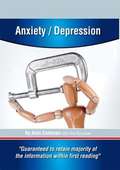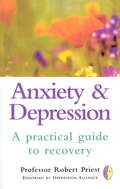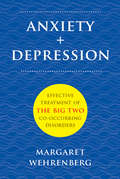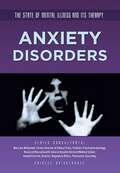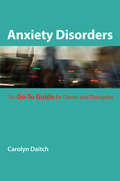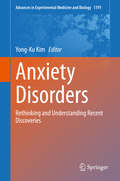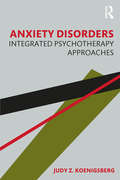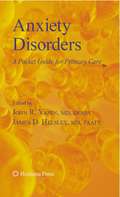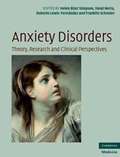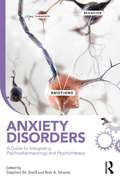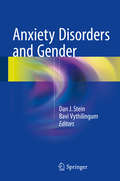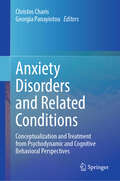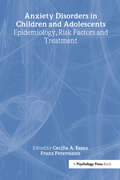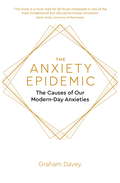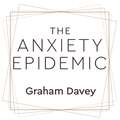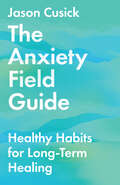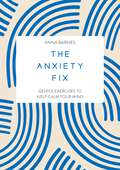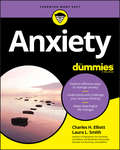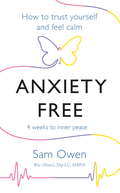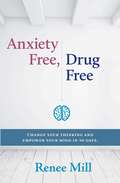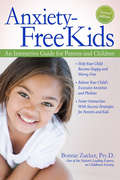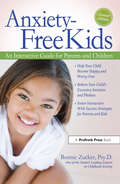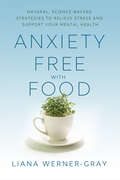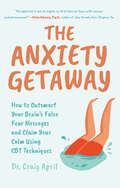- Table View
- List View
Anxiety/Depression
by Alan Eastman Ron NurwisahAddressing areas of everyday life-from the anxiety of visiting the dentist to personal depression-this guide helps listeners eliminate the prohibitive nature of fear and sadness. Incorporating such techniques as visual meditation and self-recorded transcripts to listen to while sleeping, listeners learn to gain control over their negative thoughts and feelings and conquer the paralyzing and unhealthy symptoms associated with anxiety and depression.
Anxiety & Depression: A Practical Guide to Recovery
by R G PriestFeelings of anxiety and depression confront us all from time to time, and can vary in their severity. Recognising the symptoms, understanding their causes and effects, and knowing what help is available can be very reassuring and help overcome the condition. Professor Robert Priest has written this book especially to provide help for those feeling anxious and depressed. In particular he covers the practical self-help methods to reduce stress and offers an explanation of the causes and effects of anxiety and depression. The book provides up to date information on the professional help available and details the action and side-effects of medications.
Anxiety + Depression: Effective Treatment of the Big Two Co-Occurring Disorders
by Margaret WehrenbergTips and techniques for managing a prevalent co-existing condition. Anxiety and depression are two of the most common complaints in therapy, and its not unusual for clients to suffer from both simultaneously. But spotting the co-occurrence is not easy. When one symptom picture dominates, diagnosis and treatment are pretty straightforward. But consider how fuzzy the clinical picture can become: Depression can rob an anxious client of the energy needed to control her symptoms; acute anxiety can make anyone depressed and exhausted; and what happens when anxiety masquerades as depression, or vice versa? What are the signs that this is happening? It's hard enough to treat these two disorders when they exist on their own, and it gets even harder when they present together. In her customary practical style and conversational tone, Margaret Wehrenberg unravels the complexity of this common comorbidity, teaching therapists exactly how to tackle it. Beginning with "Where to Start?", she walks readers through a variety of common tricks for distinguishing between anxiety and depression, and provides an assessment plan for determining which set of symptoms the client is most ready to work on. The book goes on to highlight seven common types of comorbid clients, who can be arrayed on a spectrum, from the "low energy" (depressed) on one end to the "high anxiety" (anxious) on the other, and everything in between, including the "hopeless ruminator," the "quiet avoider," and the "high-energy anxious and depressed" client. By organizing the book around these typical client profiles, readers are given a more realistic picture of what comorbid anxiety and depression look like and how to best help their clients. Wondering where depression ends and anxiety begins, or vice versa, and how you can most effectively help your clients when they're struggling with both? The key clinical strategies offered in this book provide a practical roadmap forward, helping therapists and their clients to better understand the symptom picture, manage its effects, and heal.
Anxiety Disorders (The State of Mental Illness and Its Ther #19)
by Shirley BrinkerhoffWhen terrorists attacked the World Trade Center on September 11, 2001, Cassie McCauley watched in horror from her classroom on the New Jersey side of the Hudson River. Her heart pounded faster and faster as she saw billowing clouds of dark gray smoke pour from the landmark buildings. When the first tower collapsed, she began feeling light-headed. By the time the second tower fell in on itself, Cassie was so nauseated and dizzy she had to sit down. Along with millions of people across North America and around the world, Cassie grieved for the families who lost relatives and friends. But she never anticipated the changes September 11 would cause in her own life. Soon she found herself unable to go to school and barely able to function. Cassie was experiencing an anxiety disorder. Anxiety disorders are the most common psychiatric illnesses in North America. Estimates are that at least one of every twenty Americans will suffer from an anxiety disorder at some time. These disorders can happen for many reasons. As in Cassie's case, they can be triggered by traumatic and devastating events. In other cases, they can appear seemingly without reason. Nearly everyone at one time or another experiences anxious feelings, so some people assume that an anxiety disorder is not a serious condition. In Anxiety Disorders, however, you will learn how serious anxiety disorders can be. Through Cassie's story, and the stories of other people like her, you will explore the many different forms of anxiety disorders, the impacts they have on people's lives, and the treatments available to help. Discover just how prevalent anxiety disorders are and learn about the new ways doctors are fighting these all-too common forms of mental illness.
Anxiety Disorders: The Go-To Guide for Clients and Therapists (Go-To Guides for Mental Health)
by Carolyn DaitchA comprehensive and accessible book on anxiety for clients and therapists alike. Anxiety disorders are the number-one psychiatric problem in the United States, yet many clients who suffer from anxiety do not get effective counseling, and they often end therapy without successful amelioration of their symptoms. Carolyn Daitch, a seasoned therapist and award-winning author, has found that clients bene?t most when they are active participants in their therapy, and should be knowledgeable about anxiety disorders to facilitate this process. For the bene?t of both therapists and clients, she covers the ins and outs of the anxiety disorders--Generalized Anxiety Disorder, Panic Disorder, Speci?c Phobias, Social Anxiety Disorder, and Obsessive Compulsive Disorder--and offers numerous case examples of those who have sought treatment for these disorders and learned to manage them. For each type of anxiety disorder, she details speci?c treatment options and techniques, explaining which are best suited to individual use, and which are better done in collaboration with a therapist. Engaging, comprehensive, and reassuring, this is an essential Go-To Guide.
Anxiety Disorders: Rethinking and Understanding Recent Discoveries (Advances in Experimental Medicine and Biology #1191)
by Yong-Ku KimThis book reviews all important aspects of anxiety disorders with the aim of shedding new light on these disorders through combined understanding of traditional and novel paradigms. The book is divided into five sections, the first of which reinterprets anxiety from a network science perspective, examining the altered topological properties of brain networks in anxiety disorders. The second section discusses recent advances in understanding of the neurobiology of anxiety disorders, covering, for example, gene-environmental interactions and the roles of neurotransmitter systems and the oxytocin system. A wide range of diagnostic and clinical issues in anxiety disorders are then addressed, before turning attention to contemporary treatment approaches in the context of novel bio-psychosocial-behavioral models, including bio- and neurofeedback, cognitive behavioral therapy, neurostimulation, virtual reality exposure therapy, pharmacological interventions, psychodynamic therapy, and CAM options. The final section is devoted to precision psychiatry in anxiety disorders, an increasingly important area as we move toward personalized treatment.Anxiety Disorders will be of interest for all researchers and clinicians in the field.
Anxiety Disorders: Integrated Psychotherapy Approaches
by Judy Z. KoenigsbergThis text provides integrated and unified treatment frameworks for anxiety disorders and examines how contemporary integrated psychotherapy treatment models from different therapeutic interventions can be used to help patients. Dr. Koenigsberg provides a research-based overview of major themes that underlie these treatment models, then analyzes the symptoms and causes of specific anxiety disorders such as panic disorder, social anxiety disorder, and phobias, as well as obsessive-compulsive disorder, and posttraumatic stress disorder. Case studies of integrated or unified treatment approaches are provided for each disorder, along with the theoretical and technical factors that are involved in applying these approaches in clinical practice. Supplementary online materials include PowerPoint slides and test questions to help readers further expand their understanding of integrated and unified approaches for the anxiety disorders and assess their newfound knowledge. Graduate and undergraduate students, novice and seasoned therapists, and researchers will learn the rationale for and the history of past and contemporary integrated and unified models of treatment to gain better insight into anxiety disorders.
Anxiety Disorders: A Pocket Guide For Primary Care (Current Clinical Practice)
by D. M. Morgan John Vanin James HelsleyThis pocket guide is designed to help the primary care practitioner recognize, diagnose, and manage anxiety disorders in a busy clinical practice. It presents an easy-to-follow, step-by-step approach, and offers practical points based on both real patient-care experience and review of current medical literature. The guide includes helpful chapters on psychopharmacology, psychopharmacotherapy, and psychologic treatment for the anxiety disorders.
Anxiety Disorders: Theory, Research and Clinical Perspectives
by Helen Blair Simpson Yuval Neria Roberto Lewis-Fernández Franklin SchneierAnxiety disorders are amongst the most common of all mental health problems. Research in this field has exploded over recent years, yielding a wealth of new information in domains ranging from neurobiology to cultural anthropology to evidence-based treatment of specific disorders. This book offers a variety of perspectives on new developments and important controversies relevant to the theory, research, and clinical treatment of this class of disorders. Clinicians will find reviews of state-of-the-art treatments for panic disorder, social anxiety disorder, phobias, obsessive-compulsive disorder, generalized anxiety disorder, and post-traumatic stress disorder, as well as controversies over diagnostic and treatment issues. Researchers will find in-depth consideration of important selected topics, including genetics, neuroimaging, animal models, contemporary psychoanalytic theory, and the impact of stressors. This book illustrates the enormous advances that have occurred in anxiety research and describes the evolving multi-disciplinary efforts that will shape the future of the field.
Anxiety Disorders: A Guide for Integrating Psychopharmacology and Psychotherapy (Clinical Topics in Psychology and Psychiatry)
by Stephen M. Stahl Bret A. MooreDrs. Stephen M. Stahl and Bret A. Moore have created an instant classic in Anxiety Disorders: A Guide for Integrating Psychopharmacology and Psychotherapy. Anxiety Disorders is a comprehensive reference for the psychiatry and psychology student, intern, or resident, early career psychiatrist or psychologist, and the busy clinician. It distills the most important information regarding combined treatments for anxiety and presents the material in an easily accessible, understandable, and readable format. Each chapter addresses a specific type of disorder: PTSD, panic, generalized anxiety, obsessive-compulsive and other disorders, and is authored by prominent clinicians with years of experience in providing integrated, individualized treatments. With its thorough exploration of psychopharmacological treatments, psychosocial treatments, and, crucially, the integration of the two, Anxiety Disorders is a text no 21st-century clinician or student can afford to be without.
Anxiety Disorders and Gender
by Dan J. Stein Bavi VythilingumAnxiety and related disorders are common conditions that disproportionately affect women. In this book, the epidemiology, psychobiology, diagnosis, evaluation, pharmacotherapy and psychotherapy of major anxiety and related disorders are examined with special reference to the effects of gender and sex on clinical presentation and treatment. The conditions considered include generalized anxiety disorder, obsessive-compulsive disorder, panic disorder, posttraumatic stress disorder and social anxiety disorder. In addition, the management of anxiety and related disorders during pregnancy and lactation are discussed. Two concluding chapters specifically address anxiety disorders in women and in men, summarizing key points for clinicians and researchers. The authors are leading clinicians, including both psychiatrists and psychologists, from around the globe.
Anxiety Disorders and Related Conditions: Conceptualization and Treatment from Psychodynamic and Cognitive Behavioral Perspectives
by Christos Charis Georgia PanayiotouThe volume aims to instigate a dialog between the psychoanalytic and the cognitive-behavioral tradition on conceptualization and treatment of anxiety disorders and related conditions through contributions of respective experts. It presents current findings, and current theories and conceptualizations with regards to the mechanisms of etiology and maintenance of anxiety and related conditions, as well as innovative, new or experimental approaches to treatment that target core difficulties found in patients with anxiety. The book integrates basic research with conceptualization and treatment, while giving space for multiple perspectives to treatment, both psychotherapeutic and pharmacological, to be described. Chapters include a) conceptualization and treatment of anxiety and panic from psychodynamic perspectives, b) 2nd wave CBT treatment and the use of virtual reality, c) 3rd wave (ACT) perspectives, and d) neuroendocrine factors, and e) pharmacotherapy perspectives. Different theoretical approaches are presented highlighting the strengths and the evidence in favour of each approach, without promoting any specific perspective, but with an effort to highlight common underlying themes like safety behaviors and avoidance, social support, and role of learning history. In this way the book will present a combination of theory, science and practice aiming to be an excellent resource for researchers, clinicians and students of mental health professions.
Anxiety Disorders in Children and Adolescents: Epidemiology, Risk Factors and Treatment
by Cecilia A. Essau Franz PetermannRecent years have seen a growing awareness of the common occurrence of anxiety disorders in children and adolescents. There has been a parallel increase in the number of studies examining the risk factors, comorbidity, course and outcome of such disorders, as well as the developments of numerous preventative and intervention strategies.The aim of Anxiety Disorders in Children and Adolescents is to present a comprehensive summary of the most recent empirical findings in this area. Written by eminent researchers and clinicians from Europe and America, the book is divided into three broad sections. The first provides a general overview of anxiety disorders in the young, outlining classification and assessment strategies as well as research methods and design. Part two contains chapters on the seven subtypes of anxiety disorder, including panic disorder, obsessive-compulsive disorder and posttraumatic stress disorder. The final section deals with the progress that has been made in the understanding of such disorders and provides recommendations for future investigation.Anxiety Disorders in Children and Adolescents is intended for students, researchers and other professionals in the fields of psychology, psychiatry, pediatrics and social work.
The Anxiety Epidemic: The Causes of our Modern-Day Anxieties
by Graham DaveyHighly commended at the British Medical Association Book Awards 2019Are we living in an age of unprecedented anxiety, or has this always been a problem throughout history?We only need look around us to see anxieties: in the family home, the workplace, on social media, and especially in the news. It's true that everyone feels anxious at some time in their lives, but we're told we're all feeling more anxious than we've ever been before - and for longer than we've ever done before. It's even reported that anxiety is a modern epidemic significant enough to challenge the dominance of depression as the most common mental health problem.Much of this increase has been attributed to changes in lifestyles that have led to more stress and pressure being placed on people: from childhood, to adolescence, to adulthood. But that's a big claim. Going back over the generations, how anxious were people in 1968 or 1818? Are people just anxious all the time - regardless of what they do or when they lived? Is anxiety an inevitable consequence of simply being alive?Graham Davey addresses many important questions about the role of anxiety. What is it good for? What are the unique modern-day causes of our anxieties and stresses? What turns normal everyday anxiety into the disabling disorders that many of us experience - distressing and debilitating conditions such as phobias, social anxiety, panic disorder, obsessive compulsive disorder, pathological worrying and post-traumatic stress disorder? To truly conquer anxiety, we need to understand why it has established its prominent place in our modern world.
The Anxiety Epidemic: The Causes of our Modern-Day Anxieties
by Graham DaveyHighly commended at the British Medical Association Book Awards 2019Are we living in an age of unprecedented anxiety, or has this always been a problem throughout history?We only need look around us to see anxieties: in the family home, the workplace, on social media, and especially in the news. It's true that everyone feels anxious at some time in their lives, but we're told we're all feeling more anxious than we've ever been before - and for longer than we've ever done before. It's even reported that anxiety is a modern epidemic significant enough to challenge the dominance of depression as the most common mental health problem.Much of this increase has been attributed to changes in lifestyles that have led to more stress and pressure being placed on people: from childhood, to adolescence, to adulthood. But that's a big claim. Going back over the generations, how anxious were people in 1968 or 1818? Are people just anxious all the time - regardless of what they do or when they lived? Is anxiety an inevitable consequence of simply being alive?Graham Davey addresses many important questions about the role of anxiety. What is it good for? What are the unique modern-day causes of our anxieties and stresses? What turns normal everyday anxiety into the disabling disorders that many of us experience - distressing and debilitating conditions such as phobias, social anxiety, panic disorder, obsessive compulsive disorder, pathological worrying and post-traumatic stress disorder? To truly conquer anxiety, we need to understand why it has established its prominent place in our modern world.
The Anxiety Field Guide: Healthy Habits for Long-Term Healing
by Jason CusickAnxiety is one of the most pressing mental health issues of our day.The Anxiety Field Guide
The Anxiety Fix: Gentle Exercises to Help Calm Your Mind
by Summersdale PublishersAnxiety can feel like a huge obstacle to living the life you want - but it doesn't have to be! The prompts and exercises in this guided journal will help you to work through your worries, develop your self-belief, learn coping strategies and more, giving you the tools to conquer your anxiety, boost your well-being and live a happier life.
Anxiety For Dummies: 2nd Edition (For Dummies Ser.)
by Charles H. Elliott Laura L. SmithExplore effective ways to manage anxiety Understand and challenge your anxious thinking Make meaningful life changes Manage anxiety—and start living your life! If you feel like your life is spinning out of control, you're definitely not alone! While anxiety is a natural reaction to stress, for some of us, it can become all-consuming—and ultimately debilitating. Thankfully, there is plenty you can do to combat anxiety with the help of this approachable guide. Inside, find out how adopting proven techniques like pinpointing triggers, improving health and eating habits, and learning to let go can help you effectively and deliberately manage your worries—and take back control of your life. Inside... Recognize symptoms Know useful vs. toxic anxiety Examine the causes of your anxiety Develop the practice of mindful acceptance Help your kids with their anxiety Block the blues Face your fears Adopt anxiety-reducing habits
Anxiety Free: How to Trust Yourself and Feel Calm
by Sam OwenA PRACTICAL GUIDE TO RESOLVING ANXIETYIn today's fast-paced, always-on world, many of us experience anxiety of some kind. But it doesn't matter whether it's crippling your everyday life or you find it rearing its head in specific situations, there are ways to work through it - and this book will equip you with the know-how to do just that.Using her tried and tested three-pillar system - identify the cause, identify the solutions, take thoughtful action - acclaimed life coach Sam Owen explains that anxiety is not your enemy, it's an indication that something in your life isn't right. By activating the three pillars and using the practical tools and step-by-step guide Sam presents you with, you can root out what's going wrong and thereby resolve your anxiety within just four weeks - enabling you to get back to the calm and positivity you so deserve.Sam Owen's Anxiety Free has featured in/on:CosmopolitanGood HousekeepingPrimaNetdoctorRunners WorldStylist MagazineRefinery 29PsychologiesBBC Radio 5 LiveBBC Radio ScotlandBBC Radio ManchesterBBC Radio StokeRed Smart Women WeekNHS EnglandHuddersfield Literature FestivalTEDx
Anxiety Free: How to Trust Yourself and Feel Calm
by Sam OwenA PRACTICAL GUIDE TO RESOLVING ANXIETYIn today's fast-paced, always-on world, many of us experience anxiety of some kind. But it doesn't matter whether it's crippling your everyday life or you find it rearing its head in specific situations, there are ways to work through it - and this book will equip you with the know-how to do just that.Using her tried and tested three-pillar system - identify the cause, identify the solutions, take thoughtful action - acclaimed life coach Sam Owen explains that anxiety is not your enemy, it's an indication that something in your life isn't right. By activating the three pillars and using the practical tools and step-by-step guide Sam presents you with, you can root out what's going wrong and thereby resolve your anxiety within just four weeks - enabling you to get back to the calm and positivity you so deserve.
Anxiety free, Drug Free: Change Your Thinking And Empower Your Mind In 90 Days
by Renee MillA Simon & Schuster eBook. Simon & Schuster has a great book for every reader.
Anxiety-Free Kids: An Interactive Guide for Parents and Children
by Bonnie ZuckerAnxiety-Free Kids (2nd ed.) offers parents strategies that help children become happy and worry free, methods that relieve a child's excessive anxieties and phobias, and tools for fostering interaction and family-oriented solutions. Using a unique companion approach that offers two books in one-a practical, reader-friendly book for parents and a fun workbook for kids-this solutions-oriented guide utilizes the cognitive-behavioral approach to therapy and integrates the parent in the child's self-help process. Research has shown that if left untreated, children with anxiety disorders are at higher risk to perform poorly in school, to have less-developed social skills, and to be more vulnerable to substance abuse. Covering the six most commonly occurring anxiety disorders-generalized anxiety, separation anxiety, specific phobias, social phobias, panic disorder, and obsessive-compulsive disorder-this book gives kids and parents successful strategies for achieving relaxation, conquering worries, challenging faulty thinking patterns, developing positive self-talk, and facing one's fears.
Anxiety-Free Kids: An Interactive Guide for Parents and Children
by Bonnie ZuckerAnxiety-Free Kids (2nd ed.) offers parents strategies that help children become happy and worry-free, methods that relieve a child's excessive anxieties and phobias, and tools for fostering interaction and family-oriented solutions. Using a unique companion approach that offers two books in one—a practical, reader-friendly book for parents and a fun workbook for kids—this solutions-oriented guide utilizes the cognitive-behavioral approach to therapy and integrates the parent in the child's self-help process.Research has shown that if left untreated, children with anxiety disorders are at higher risk to perform poorly in school, to have less-developed social skills, and to be more vulnerable to substance abuse. Covering the six most commonly occurring anxiety disorders—generalized anxiety, separation anxiety, specific phobias, social phobias, panic disorder, and obsessive-compulsive disorder—this book gives kids and parents successful strategies for achieving relaxation, conquering worries, challenging faulty thinking patterns, developing positive self-talk, and facing one's fears.Educational Resource
Anxiety-Free with Food: Natural, Science-Backed Strategies to Relieve Stress and Support Your Mental Health
by Liana Werner-GrayRelease stress and anxiety naturally with this simple yet comprehensive nutrition guide that supports your mental health from Liana Werner-Gray, author of Cancer-Free with Food.Eat your way to calm . . .If you're feeling anxious, stressed, or depressed, you're not alone. The world may be in turmoil-but inside, we can feel unwavering peace. We can support our mental and physical health by avoiding anxiety-inducing ingredients and choosing foods and supplements that support our microbiome, address nutritional deficiencies, and balance our hormones.Liana Werner-Gray, nutritionist and author of The Earth Diet and Cancer-Free with Food, offers this simple guide to all the scientifically backed, nutrient-rich foods and supplements you need to support your emotional wellness. She offers 100+ delicious gluten-free, soy-free, refined sugar-free, and dairy-free recipes that both nourish the body and support optimal brain function. With Liana's easy strategies based on nutritional neuroscience, you'll feel empowered to take control of your mental well-being.Remember, life is meant to be enjoyed. Let your first step toward an anxiety-free life start with your next meal!
The Anxiety Getaway: How to Outsmart Your Brain's False Fear Messages and Claim Your Calm Using CBT Techniques
by Craig AprilLearn how to overcome fear and relieve your anxiety through cognitive behavioral therapy. Many of the available resources for managing anxiety are based on opinion rather than science. Dr. Craig April, founder of The April Center for Anxiety Attack Management, relies on the latter. By employing Cognitive Behavioral Therapy (CBT), he helps readers overcome fear for the anxiety relief they desire. Assuming the role of victim when it comes to anxiety can make us feel trapped and convince us that we have no control in getting better. However, Dr. April has found that in most of its forms, anxiety is not a mental health disorder. In fact, anxiety relief begins by facing our fears. Using a stripped-down, no-nonsense approach to anxiety, Dr. April takes CBT techniques and tackles anxiety at the root: false fear messages. Fear is a factor in all lives, whether we feel it plays a significant role in controlling us or not. Lucky for us, it is also something that can be faced. By recognizing anxiety as a result of false fear messages, we become better equipped to manage it. An expert in Cognitive Behavioral Therapy for anxiety relief, Dr. April uses over twenty years of experience to help readers face their fears and overcome their anxiety. In this indispensable book on anxiety relief for adults, you&’ll discover: Effective anti-anxiety methods used at The April Center for Anxiety Attack ManagementA non-victim approach to help you take back control and reclaim your lifeTips and practical tools to overcome fearPraise for The Anxiety Getaway&“With humor and compassion, Dr. Craig April tells you to &“do the work to claim your calm&” and shows you the path to get there. This book is filled with solid, practical advice to defeat anxiety, based on scientifically backed techniques and years of clinical experience. His approach is sure to inspire us all to face our fears with courage and perseverance!&” —Helen Odessky, PsyD, author of Stop Anxiety from Stopping You&“All I can say is thank the Lord for Dr. Craig April and The Anxiety Getaway. I hope you take the time to check out this new book and that you are able to use the advice in your life like my family did.&” —Mommies Reviews
